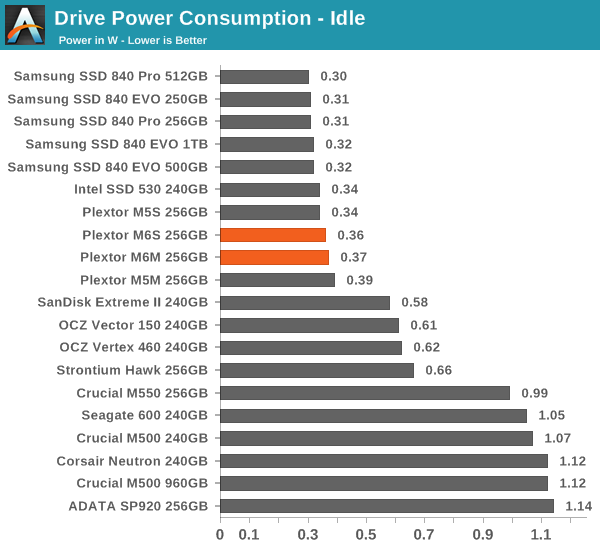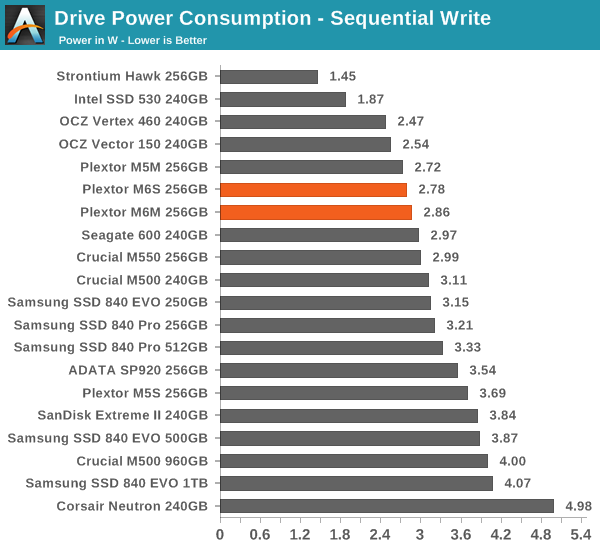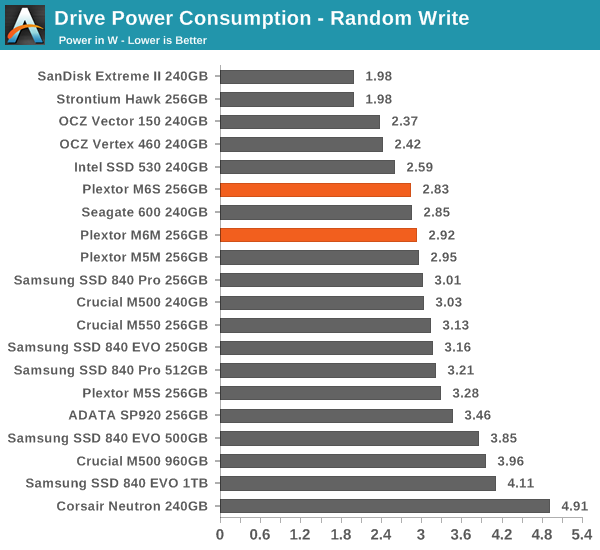Plextor M6S & M6M (256GB) Review
by Kristian Vättö on April 10, 2014 6:00 AM ESTPower Consumption
In the ADATA SP920 review, I mentioned that I finally was collecting slumber power numbers for all the drives I have tested, but I hadn't tested enough drives to meet the strict deadline for the SP920 review. I now have the numbers to share. I'm only including the most relevant drives here but you can find all the results in out Bench.
Note that these results differ from the ones Anand has published earlier due to the fact that we are using totally different testbeds. Anand is using a modified laptop and only measures the current on the 3.3V rail, whereas I'm using our 2014 SSD testbed, which is a desktop system. I was surprised that the system even supported HIPM+DIPM as traditionally those are mobile-only features, but with aggressive link power management enabled in the BIOS, I was able to get them to work on a desktop as well. Unfortunately my multimeter only supports current measurement at the accuracy of one milliamp, so the results go in multiples of five (0.001A*5V is 5mW, so that's the smallest increment).
The M6S and M6M do pretty well here. Out of the drives that support low power states, the M6S and M6M are mediocre, but having the support is more important than the actual numbers. Whether the drive consumes 80mW or 40mW at idle won't make a huge difference to the battery life but 80mW vs 800mW certainly does. Both drives also support DevSleep and Plextor claims power consumption as low as 2mW but unfortunately we don't have the tools to test that yet (it is in the works, though).
Power consumption under load is also very good. The days of super power hungry SSDs are fortunately over and most drives stay easily below 4W, but keeping below 3W in all cases is still quite rare.














30 Comments
View All Comments
prime2515103 - Thursday, April 10, 2014 - link
I find it disappointing how average Plextor has become, yet they keep their pricing at a point where one might expect to get something at least slightly exceptional.I do have an M5M in my laptop and haven't had any problems with it, so I'll give them that. The selection of mSATA drives was pretty sparse when I bought it though, and it was on sale for $108 (which was quite good at the time), otherwise it definitely would not have been my first choice.
Cellar Door - Thursday, April 10, 2014 - link
I agree, I will be going with samsung evo for my msata drive. Very disappointing for the price.Samus - Thursday, April 10, 2014 - link
M500 is still the best deal for an average, reliable SSD. Great for basic business and family PC's.rufuselder - Thursday, October 9, 2014 - link
Me too. But either way, there are some much better storage options out there. /Rufus from http://www.consumertop.com/best-computer-storage-g...dylan522p - Thursday, April 10, 2014 - link
That was good basic explanation of the differences between everyones NAND! Thanks for doing that.nathanddrews - Thursday, April 10, 2014 - link
The pictures of the IMFT and Samsung processes are all clean and uniform... the Toshiba and Hynix processes look like a 3-year-old with a crayon made them.zodiacsoulmate - Thursday, April 10, 2014 - link
yea... why they look like that? maybe they are hard to color? why they look so random...extide - Thursday, April 10, 2014 - link
LOL, I noticed that too, it's like, geez how does that stuff even work! Looks so sloppy!Kristian Vättö - Friday, April 11, 2014 - link
Keep in mind that the diameter of the photo is a few dozen nanometers and it's extremely hard to achieve 100% precision with lithographies that small. At least IMFT has been using air gaps before and it's a mature process for them but Toshiba and Hynix added them to the current generation, making it quite new for them.creed3020 - Thursday, April 10, 2014 - link
Kristian thanks for such an in-depth technical and product review. I really appreciate how in your reviews graphs are accompanied with text explaining the results and providing an opinion on the results. I can read a graph but interpretation of those graphs and data trends is often missing from reviews here at AT.I am surprised that such a new drive isn't also available in M2 format but I guess they have the M6e for that. Is there a review of that drive coming as well?